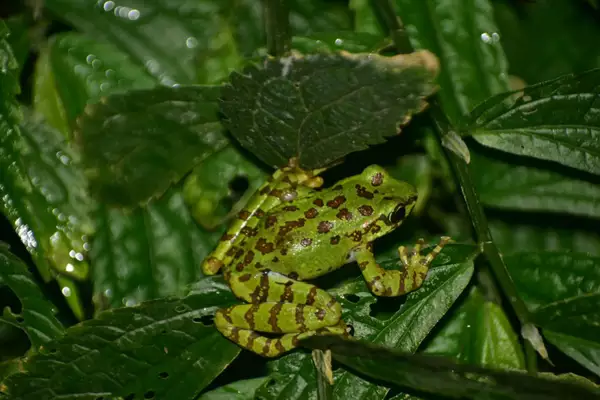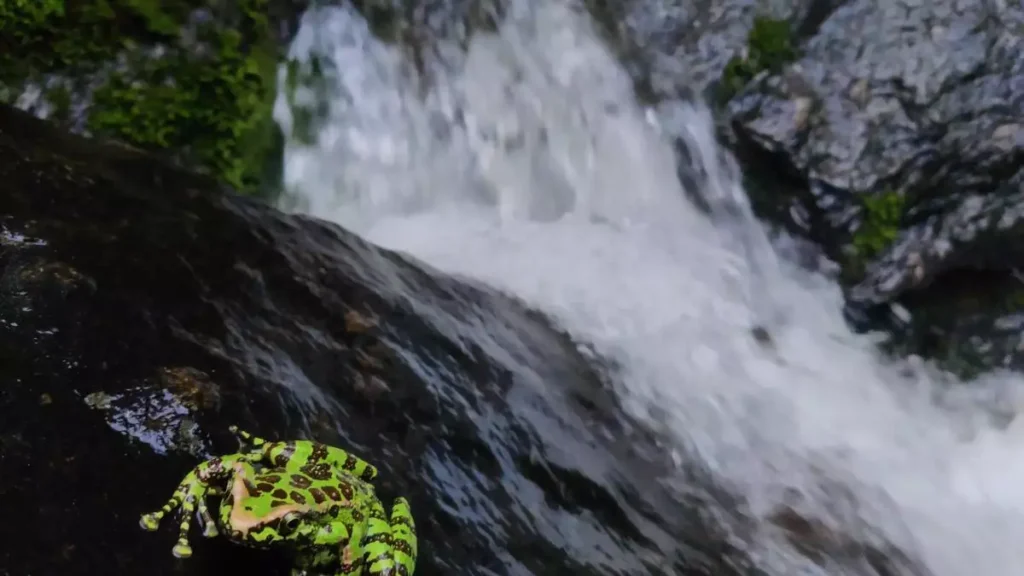Scientists from the Wildlife Institute of India (WII) recently studied Assam cascade or hill stream frog, in two Himalayan streams of the Churdhar Wildlife Sanctuary, Himachal Pradesh.
About Assam cascade or hill stream frog:
- It is an amphibian found in fast-flowing, high-gradient hill streams in the Himalayan region (India, Bangladesh, Bhutan, Nepal).
- Its scientific name is Amolops Formosus and also known as the Assam sucker frog, beautiful stream frog, and hill stream frog.
- Appearance: Greenish-brown body with dark spots, helping it blend into the rocky stream environments, and a streamlined body shape, aiding in movement through water currents.
- The habitat thrives at elevations between 1,000 and 2,508 meters above sea level.
- Unique features: They possesses adhesive disks, with circum-marginal grooves, on the tips of its fingers and toes, allowing it to stick to rocks and other surfaces in fast-moving water.
- Such frogs are associated with high-flowing hill streams, but it requires an optimal flow between 1.3 and 1.7 meters per second for optimal presence.
- Indicator Species: It acts as an indicator species for monitoring the health of hill stream ecosystems, reflecting changes in water quality and flow.
- An indicator species is a species whose presence, absence, or abundance in a given environment reflects the overall health and condition of that ecosystem.
- Behavioral Adaptations: Highly adapted to nocturnal activity, taking advantage of cooler temperatures and reduced predation risks.
About Churdhar Wildlife Sanctuary:
- It is located in the Sirmaur district of Himachal Pradesh, perched on the Churdhar Peak, the highest mountain in the outer Himalayas.
- The Satluj River lies to the south, and Badrinath to the north, surrounded by small streams and rivulets.
- The Great Himalayan National Park is located to the west, Rajaji National Park to the south, and Sirmaur Wildlife Sanctuary in the Sirmaur district.
- Flora includespredominantly oak and deodar forests, medicinal plants like Wild Himalayan Cherry, Aloe Vera (Dhrit Kumari), and Amaranthus spinosus (Chulai), etc.
- Fauna includes mammals like musk deer, barking deer, Himalayan Black Bear, Leopard, Langur, Goral, Asiatic Black Bear and Pika.
- Major threats can be habitat loss due to human encroachment, illegal hunting, wildlife trade, climate change, and increasing tourism.
Ref: Source
| UPSC IAS Preparation Resources | |
| Current Affairs Analysis | Topperspedia |
| GS Shots | Simply Explained |
| Daily Flash Cards | Daily Quiz |
Frequently Asked Question:
What is the Assam cascade or hill stream frog?
The Assam cascade frog, scientifically known as Amolops formosus, is an amphibian found in fast-flowing, high-gradient hill streams in the Himalayan region (India, Bangladesh, Bhutan, and Nepal).
What are some common names for Amolops formosus?
This frog is also known as the Assam sucker frog, beautiful stream frog, and hill stream frog.
What does the Assam cascade frog look like?
It has a greenish-brown body with dark spots that help it blend into its rocky stream environment. Its streamlined body shape is adapted for efficient movement through water currents.



